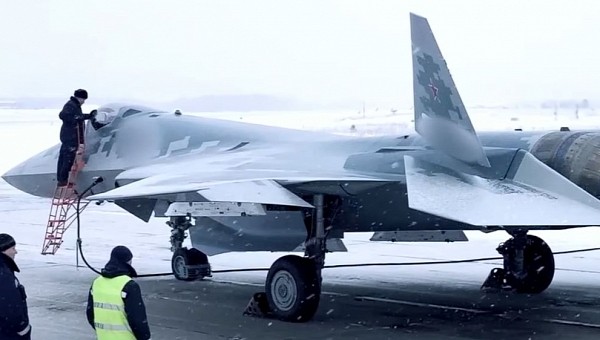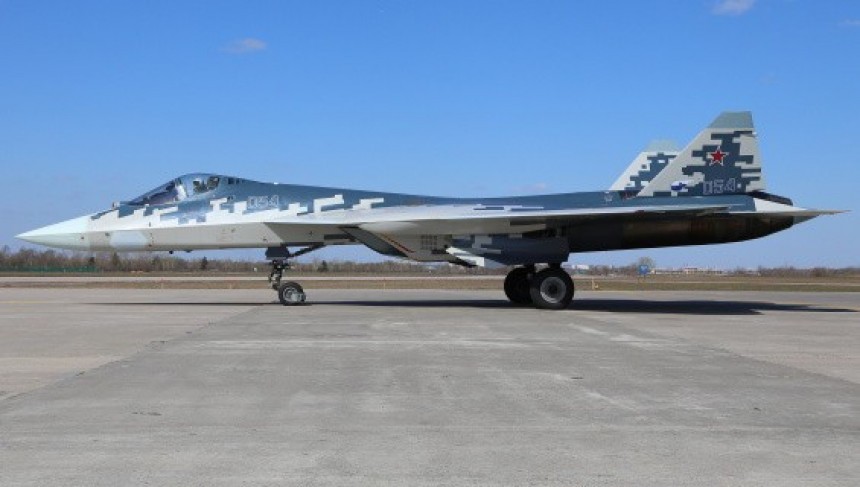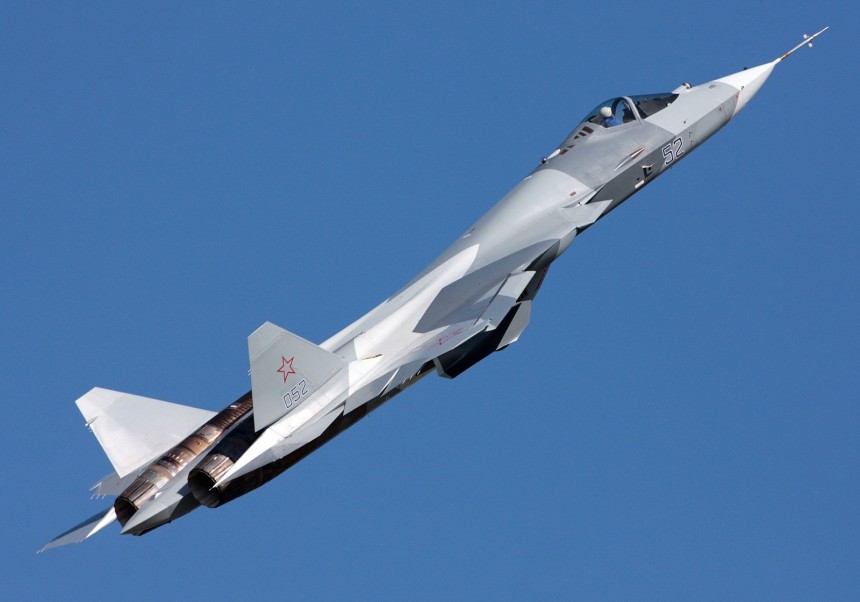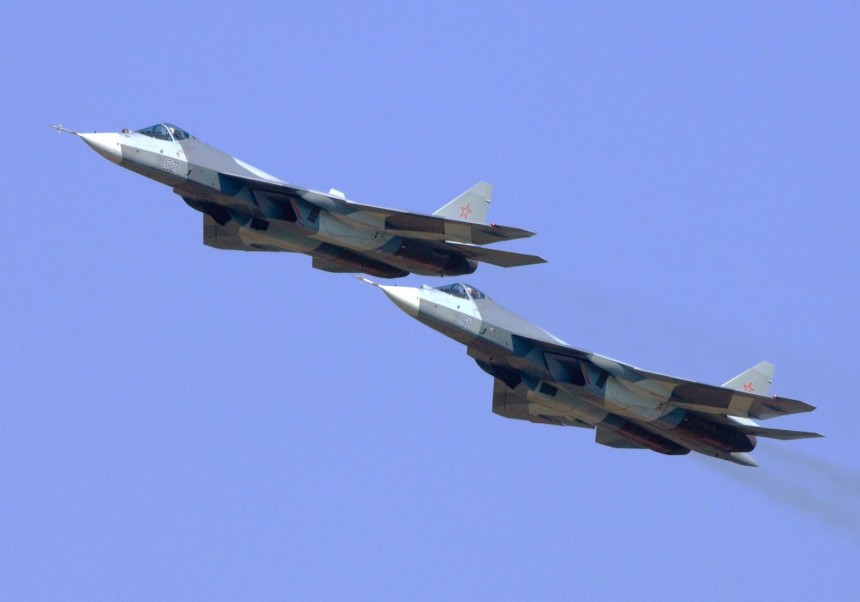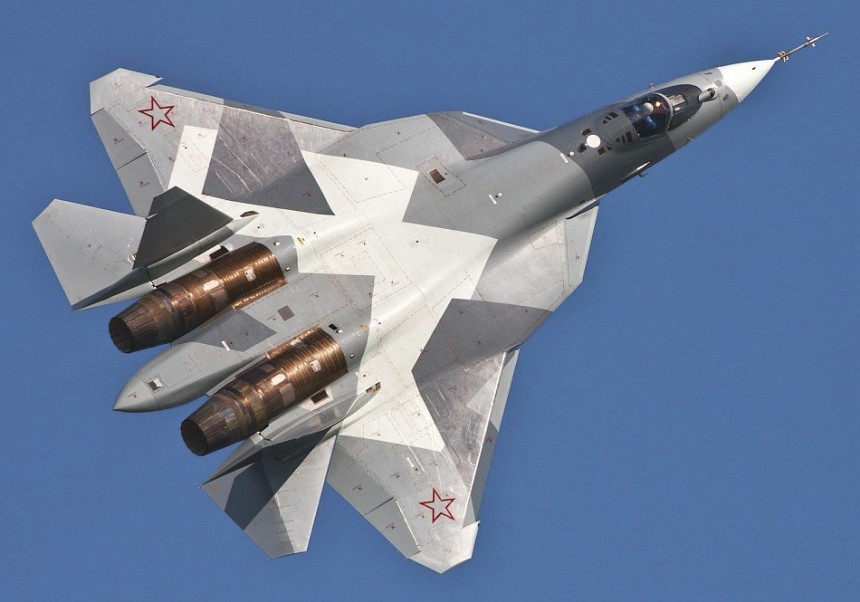You may have heard through the grapevine that Russia, as entrenched as they are in their "special operation" in Ukraine, just collected a fresh batch of their prized Sukhoi Su-57 gen-V jet fighter (NATO Codename: Felon).
It was the job of the state-operated United Aircraft (UAC) group to deliver the last of Russia's flagship fighter jets slated for operation in 2022. At last count, estimates have pegged the total number of operation Su-57s as of 2023 to 76. Considering that number was only 21 as of 2018, including prototypes, the real figure is anyone's guess.
This particular batch of Su-57s comes courtesy of the Komsomolsk-on-Amur Aircraft Plant (KnAAZ) in the country's far east. Many hundreds of miles away from the largest European conflict of the 21st century on the nation's western border. But despite the clear intention on the part of the Russian Federation to show off its deadliest warplane, it's doubtful NATO is too flustered.
Why? Well, more goes into it than just the F-22 and F-35. But between you and us, has anyone even seen a single Su-57 flying around anywhere remotely close to Ukrainian air space? A few silhouettes that only vaguely looked like the Felon have been spotted, but zero confirmations. So what gives? Why is the Russian Federation so wishy-washy with their F-22 Raptor parallel?
Knowing the history behind the whole debacle would probably help to understand this head-scratcher. You see, the Su-57 has gone by many names. The litany of demonstrators built to develop the Su-57's technology has gone by even more. But the real meat and potatoes behind Russia's fifth-generation fighter date back to the late 1970s.
Even before the Advanced Tactical Fighter project that sired the F-22 was a glint on the proverbial horizon, the Soviet Union, at least to a degree, knew the United States was due to make a quantum leap ahead of Iron Bloc nations. This notion was true both in terms of military aerospace capabilities and from an economic standpoint.
The results in the air of foreign wars where U.S.-backed countries like Israel and Iran thrashed Soviet-aligned combatants like Iraq and Syria proved this to be true. Though the Iranians wouldn't be Western-affiliated for much longer by early 1979, the success of their F-14 Tomcat against the Iraqis and Israel's F-15 Eagle against Arab-affiliated countries proved the Soviets needed to do something quickly.
The resulting initiative for the next generation of Soviet jet fighters was dubbed project I-90; after its projected operational debut in 1990. But any history buff will tell you it's hard to field a gen-V stealth fighter when your government is in an active state of collapse. That's why it's all the more impressive that not one but two ex-Soviet design bureaus managed to pull it off.
These two groups were Mikoyan-Gurevich with their MiG 1.44 project and Sukhoi with their forward-swept wing Su-37, later renamed the Su-47 Berkut (Golden Eagle). While both airframes were technically marvelous, neither reached full-scale production. This doesn't mean a substantial portion of the technology developed for the Su-47 Berkut didn't find its way onto the next great Russian fighter program, the PAK FA.
PAK FA was the first of three names this Sukhoi of many monikers would go by. That's apart from its internal development name, T-50, and its final name, the Su-57. With a construction largely comprised of proprietary Russian metal alloys and good old-fashioned titanium alloys, this jet has legitimate strong foundations.
The prized warbird is powered by twin Saturn after-burning turbofan engines with as much as 33,100 lbs (147.1 kN) of thrust each at full emergency throttle. What this translates to in non-aircraft speak is that Mach 2 should be easily attainable. Of course, the standard complement of infrared and radar-guided R-77 and R-74 missiles are on hand. But this air-to-air ordinance is also flanked by the Vympel R-37 hypersonic air-to-air missile, which parallels the American AIM-120D AMRAAM, and a 30 mm Gryazev-Shipunov GSh-30-1 cannon.
Some very special and secretive hardware for sure, on top of all the classified stealth and radar technology the Felon is reported to wield. If true, the Su-57 would be able to see its lesser gen-IV adversaries like Eurofighters, F-15s, and F-18s far better than they could see the Felon. Does it make sense now why we've yet to see an Su-57 confirmed on a Ukrainian battlefield yet?
All it would take is one lucky missile from a Ukrainian MiG-29, Su-24, or Su-27 to make four decades of Soviet-Russian fighter jet development known to Ukrainian forces. In the event that a Felon's airframe is recovered intact enough to be recovered by Ukraine, you could expect any intelligence gathered from the findings to find its way right into the hands of Russia's sworn enemy, the United States.
This wouldn't be the first time such a phenomenon has taken place. As far back as the Second World War, a Japanese Mitsubishi A6M2 Zero crashed on the remote Akutan Island of Alaska. The Americans promptly recovered the plane and test-flew it, revealing a plethora of performance faults which American pilots used to a great extent throughout the rest of the war.
Even later than that, a Soviet pilot named Viktor Belenko famously defected to the West by way of Japan in his then state-of-the-art MiG-25 Foxbat interceptor. Though NATO feared the Foxbat a rival to the F-14 Tomcat and F-15 Eagle, analysis done on Balenko's jet confirmed the MiG-25 was little more than a brutish Mach 3-capable monster. Good for intercepting bombers and reconnaissance aircraft, but the equivalent of a dually pickup truck in a dogfight.
Our point? Expect Vladimir Putin to shout many Russian expletives in the hypothetical case even a single Su-57 falls into enemy hands. In the case this happens, that special little thing Putin craves very much in Ukraine called air superiority would be little more than a pipe dream. Depending on who you talk to, the Russians never had a chance of achieving air superiority with or without the Felon.
If we were in the most-unfortunate position to be the commanding leader of the Russian Air Force, we'd be depleting our stockpiles of Su-27s, Su-30s, and MiG-29s before we'd ever expose the most prized asset in the Russian arsenal that isn't a tank or a cruise missile to even the remote possibility of falling to the enemy.
Though Russia's gotten remarkably skillful at hiding it, there's much larger fish to fry than even Ukraine. In no uncertain terms, don't expect cutting-edge gen-V Russian fighters like the Su-57 and Su-75 Checkmate to show up on a battlefield unless jolly old Uncle Sam and his NATO buddies are on their way with the full assortment of F-22s, F-35s, F/A-18s, and Eurofighters. If that comes to pass, the implications other than some awesome dogfights are not all that rosey.
This particular batch of Su-57s comes courtesy of the Komsomolsk-on-Amur Aircraft Plant (KnAAZ) in the country's far east. Many hundreds of miles away from the largest European conflict of the 21st century on the nation's western border. But despite the clear intention on the part of the Russian Federation to show off its deadliest warplane, it's doubtful NATO is too flustered.
Why? Well, more goes into it than just the F-22 and F-35. But between you and us, has anyone even seen a single Su-57 flying around anywhere remotely close to Ukrainian air space? A few silhouettes that only vaguely looked like the Felon have been spotted, but zero confirmations. So what gives? Why is the Russian Federation so wishy-washy with their F-22 Raptor parallel?
Knowing the history behind the whole debacle would probably help to understand this head-scratcher. You see, the Su-57 has gone by many names. The litany of demonstrators built to develop the Su-57's technology has gone by even more. But the real meat and potatoes behind Russia's fifth-generation fighter date back to the late 1970s.
The results in the air of foreign wars where U.S.-backed countries like Israel and Iran thrashed Soviet-aligned combatants like Iraq and Syria proved this to be true. Though the Iranians wouldn't be Western-affiliated for much longer by early 1979, the success of their F-14 Tomcat against the Iraqis and Israel's F-15 Eagle against Arab-affiliated countries proved the Soviets needed to do something quickly.
The resulting initiative for the next generation of Soviet jet fighters was dubbed project I-90; after its projected operational debut in 1990. But any history buff will tell you it's hard to field a gen-V stealth fighter when your government is in an active state of collapse. That's why it's all the more impressive that not one but two ex-Soviet design bureaus managed to pull it off.
These two groups were Mikoyan-Gurevich with their MiG 1.44 project and Sukhoi with their forward-swept wing Su-37, later renamed the Su-47 Berkut (Golden Eagle). While both airframes were technically marvelous, neither reached full-scale production. This doesn't mean a substantial portion of the technology developed for the Su-47 Berkut didn't find its way onto the next great Russian fighter program, the PAK FA.
The prized warbird is powered by twin Saturn after-burning turbofan engines with as much as 33,100 lbs (147.1 kN) of thrust each at full emergency throttle. What this translates to in non-aircraft speak is that Mach 2 should be easily attainable. Of course, the standard complement of infrared and radar-guided R-77 and R-74 missiles are on hand. But this air-to-air ordinance is also flanked by the Vympel R-37 hypersonic air-to-air missile, which parallels the American AIM-120D AMRAAM, and a 30 mm Gryazev-Shipunov GSh-30-1 cannon.
Some very special and secretive hardware for sure, on top of all the classified stealth and radar technology the Felon is reported to wield. If true, the Su-57 would be able to see its lesser gen-IV adversaries like Eurofighters, F-15s, and F-18s far better than they could see the Felon. Does it make sense now why we've yet to see an Su-57 confirmed on a Ukrainian battlefield yet?
All it would take is one lucky missile from a Ukrainian MiG-29, Su-24, or Su-27 to make four decades of Soviet-Russian fighter jet development known to Ukrainian forces. In the event that a Felon's airframe is recovered intact enough to be recovered by Ukraine, you could expect any intelligence gathered from the findings to find its way right into the hands of Russia's sworn enemy, the United States.
Even later than that, a Soviet pilot named Viktor Belenko famously defected to the West by way of Japan in his then state-of-the-art MiG-25 Foxbat interceptor. Though NATO feared the Foxbat a rival to the F-14 Tomcat and F-15 Eagle, analysis done on Balenko's jet confirmed the MiG-25 was little more than a brutish Mach 3-capable monster. Good for intercepting bombers and reconnaissance aircraft, but the equivalent of a dually pickup truck in a dogfight.
Our point? Expect Vladimir Putin to shout many Russian expletives in the hypothetical case even a single Su-57 falls into enemy hands. In the case this happens, that special little thing Putin craves very much in Ukraine called air superiority would be little more than a pipe dream. Depending on who you talk to, the Russians never had a chance of achieving air superiority with or without the Felon.
If we were in the most-unfortunate position to be the commanding leader of the Russian Air Force, we'd be depleting our stockpiles of Su-27s, Su-30s, and MiG-29s before we'd ever expose the most prized asset in the Russian arsenal that isn't a tank or a cruise missile to even the remote possibility of falling to the enemy.
